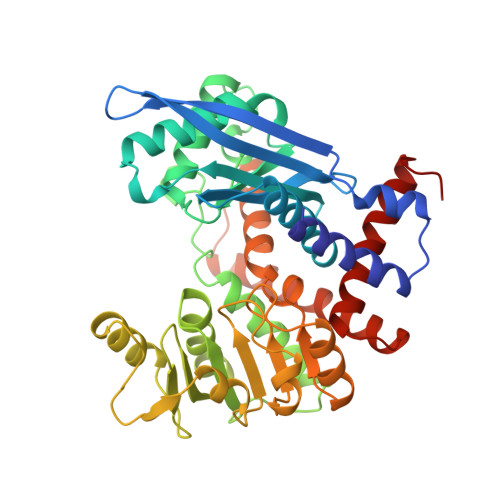Structure determination of the glutamate dehydrogenase from the hyperthermophile Thermococcus litoralis and its comparison with that from Pyrococcus furiosus
Britton, K.L., Yip, K.S., Sedelnikova, S.E., Stillman, T.J., Adams, M.W., Ma, K., Maeder, D.L., Robb, F.T., Tolliday, N., Vetriani, C., Rice, D.W., Baker, P.J.(1999) J Mol Biol 293: 1121-1132
- PubMed: 10547290
- DOI: https://doi.org/10.1006/jmbi.1999.3205
- Primary Citation of Related Structures:
1BVU - PubMed Abstract:
Glutamate dehydrogenase catalyses the oxidative deamination of glutamate to 2-oxoglutarate with concomitant reduction of NAD(P)(+), and has been shown to be widely distributed in nature across species ranging from psychrophiles to hyperthermophiles. Extensive characterisation of this enzyme isolated from hyperthermophilic organisms has led to its adoption as a model system for analysing the determinants of thermal stability. The crystal structure of the extremely thermostable glutamate dehydrogenase from Thermococcus litoralis has been determined at 2.5 A resolution, and has been compared to that from the hyperthermophile Pyrococcus furiosus. The two enzymes are 87 % identical in sequence, yet differ 16-fold in their half-lives at 104 degrees C. This is the first reported comparative analysis of the structures of a multisubunit enzyme from two closely related yet distinct hyperthermophilies. The less stable T. litoralis enzyme has a decreased number of ion pair interactions; modified patterns of hydrogen bonding resulting from isosteric sequence changes; substitutions that decrease packing efficiency; and substitutions which give rise to subtle but distinct shifts in both main-chain and side-chain elements of the structure. This analysis provides a rational basis to test ideas on the factors that confer thermal stability in proteins through a combination of mutagenesis, calorimetry, and structural studies.
Organizational Affiliation:
University of Sheffield, Sheffield, S10 2TN, UK.














